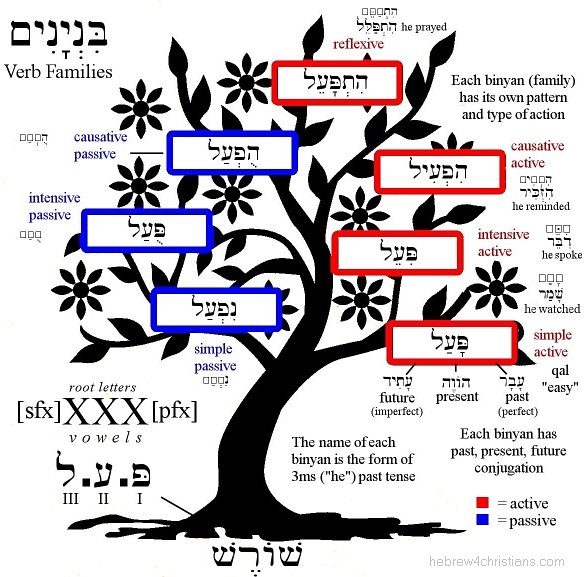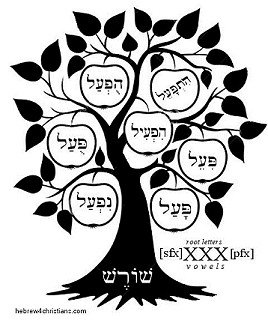|
|
 |
 |
|
Hebrew Verbs -
|
 |
 |
|
An Overview of the Hebrew Verbal System
|
 |
 |
|
Observe that the three words shown (melekh, malkhut, and malakh, respectively) all derive from the same shoresh (Mem, Lamed, Kaf). Identifying the shoresh of a given word is one of the fundamental tasks you will face as you begin to read Hebrew with comprehension.
Types of Roots...
Roots are divided into three groups known as a gizrah (ūÆų┤ų╝ū¢ų░ū©ųĖūö) with respect to one or more of its letters. For purposes of classification, each consonant of a shoresh is assigned a number (I, II, III). Strong shoreshim (i.e., roots) have no weak consonants - defined as either a guttural letter (i.e., ū©, ūó, ūŚ, ūö, ūÉ) or in some instances, a Yod (ūÖ) or Nun (ūĀ). Weak shoreshim, on the other hand, have one (or more) guttural letters which will cause changes in the vowel patterns. For instance, the Hebrew name for verb is po'al (ūżų╝ų╣ūóųĘū£) derived from a root meaning "do, perform":
 |
Notice that the shoresh for the word po'al is weak since it contains a guttural letter in its second position (II guttural). On the other hand, the verb shamar (ū®ūüū×ū©) is a strong verb since none of its three root positions contains a guttural letter (or a Yod or Nun in position I). Note that some Hebrew grammars rather confusingly refer to the root letter positions using Pey (ūż) for I, Ayin (ūó) for II, and Lamed (ū£) for III, but it seems simpler just to call them position one, two, and three, respectively. The following shows how some different roots are classified in Hebrew:

This information is provided here to make you aware that not all verbs will be conjugated (inflected) in the same way if there are guttural letters in the stem. We will provide specific examples of weak verbs and their changes as we encounter them in the lessons ahead.
|
 |
 |
|
Hebrew Verb Families...
|
 |
 |
|
A root's type of action is expressed in a particular binyan (ūæų╝ų┤ūĀų┤ūÖųĖū¤) often described as a linguistic "house" or "structure," and by extension, as an offshoot "stem," or "branch" derived from a basic root. There are seven binyanim (ūæų╝ų┤ūĀų░ūÖųĖūĀų┤ūÖūØ), each having its own vowel pattern and characteristic mode of action. When a shoresh follows that pattern its action will change but its basic meaning will be retained. Some binyanim are active (i.e., the subject does action) while others are passive (i.ee. the subject receives action). One binyan is reflexive (i.e., the subject both does and is affected by the action). The seven binyanim each have three "tenses" (past, present, and future) as well as other verbal constructions such as infinitives, so a single shoresh can be used to describe a lot of nuances regarding the characteristic action of any conjugated form. For now it is best to simply remember that a binyan is pattern of vowels (which prefixes and/or suffixes), and the name of each binyan (e.g., pa'al, piel) is the 3ms form of that pattern.
|
 |
 |
|
A verb binyan (family) is an offshoot of the root that is used to indicate the properties of voice (active or passive) and aspect (kind of action). In Hebrew the seven major binyanim are as follows:
- Pa'al Stem - Simple (Qal) action, active voice
- Piel Stem - Intensive action, active voice
- Hifil Stem - Causal action, active voice
- Hitpael Stem - Intensive action, reflexive
- Nifal Stem - Simple action, passive voice
- Pual Stem - Intensive action, passive voice
- Hofal Stem - Causal action, passive voice
Note: The pa'al stem is basic, the other stems are derived from it. Nearly 70% of verbs are pa'al.
|
|
|
 |
|
|
 |
 |
 |
 |
 |
 |
 |
 |
 |
 |
 |
 |
 |
 |
 |
 |
|
Note: This table is presented only to show you how the three-letter root changes to indicate the aspect of the verb (i.e., the stem of a given binyanim). More detailed information will be provided later on each of these stems, IY"H.
|
|
|
|
Properties of Verbs...
|
|
|
|
Like other parts of speech you have learned, Hebrew verbs have a number of grammatical properties with which you must be familiar:
- Person - Expresses the relationship between the verb and the speaker. A verb can be in the first person ("I," "we"), second person ("you," "y'all"), or third person ("he/she/it," "they"). Abbreviated using a number (as in "1" for first person).
- Number - Number is the property that indicates whether one or more than one subject is referenced when using the verb. Verbs can be singular (referring to one subject - I hit) or plural (referring to more than one object - We hit). Usually abbreviated as "s" for singular and "pl" for plural (e.g., 1s, 3pl, etc.).
- Gender - Gender is a property that indicates the sex of the referent (masculine, feminine, or common). Hebrew verbs agree with their subjects - not only in person and number - but also in gender. Thus the Hebrew verb in the two sentences "The boy ruled" and "The girl ruled" would look different because the genders of the two subjects are different. Abbreviated with "m" and "f" respectively (e.g, 2ms, 3fpl)
- Voice - The voice of a verb denotes the relationship of the action of the verb to the subject of the verb. Hebrew (like Greek) includes three voices:
- Active voice (the subject is agent of verb: "I hit")
- Passive voice (the subject is acted upon by verb: "I was hit")
- Middle voice - reflexive action (the subject both acts and is acted upon by the verb: "I hit myself")
- Aspect (Mode) - The kind of action expressed by a verb is called is aspect (or mode). Hebrew uses the following three aspects:
- Simple action (e.g., he hit)
- Intensive action (e.g., he smashed)
- Causal action (e.g., to cause to be hit). Hebrew verbs, unlike English verbs, are inflected for "causation." You can look at a verb form and tell if the subject of a sentence is "causing" something to happen to something else.
- Tense - Whereas English verbs indicate tense by means of spelling changes or through the use of "helping verbs" (e.g., I talk. I talked. I shall talk), Hebrew verbs are not marked for tense. You cannot tell - just by looking at a verb form without context - when the action occurs, however there present participles are used to indicate present action, verbs in the perfect tense indicate past (or completed) action, and verbs in the imperfect tense indicate future (or incompleted) action (though please note, these are generalizations that do not always apply). Hebrew often uses a form of the verb "to be" (or an adverb) to indicate a sense of time.
The perfect tense is sometimes called the suffixed form, whereas the imperfect us called the prefixed form (although the imperfect also uses suffixes).

- Strong/Weak Verbs - As mentioned above, verbs can be either strong or weak. A strong verb has all regular consonants in its stem; a weak verb has one (or more) guttural letters as part of its stem.
These properties of verbs are all expressed by means of patterns of inflection. That is, the person, number, gender, etc. of the verb is indicated by changes in the spelling and vowel pattern of a given verbal instance.
About Hebrew Conjugations
To make matters just a little more complicated, each of these seven binyanim can be conjugated in no less than eight different ways!
- Perfect (Past tense) - The perfect conjugation is used to denote simple, completed action. Though it is an oversimplification, for now we will translate the perfect conjugation using the simple past tense.
- Imperfect (future tense) - The imperfect conjugation is used to denote incomplete action. Though it is an oversimplification, for now we will translate the imperfect conjugation using the future tense.
- Participle (present tense) - Verbal adjective or substantive. "The praising man..."
- Imperative - Command (2nd person) "You praise the LORD!"
- Jussive - Command (3rd person) "He shall praise the LORD!"
- Cohortative - Command (1st person) "Let us praise the LORD!"
- Infinitive Construct - Verbal noun. "To praise is good."
- Infinitive Absolute - A grammatical intensifier.
We will begin our study of the Hebrew verbal system with the Pa'al (or Qal) Perfect (conjugation), and progress our way through the other branches and conjugations. For now just make sure you understand the "big picture" of the verbal system and the relationship between a given shoresh (root) and its expression as a particular verb using a pattern of vowels with different prefixes and suffixes.
|
|
|
|
Hebrew Verbal System Summary:
|
|
|
|
 |
|
|
|
|
|
|
<< Return
|
|
|
|
Hebrew for Christians
Copyright © John J. Parsons
All rights reserved.
|
|
|
|
 |
|
|
|
|
|
|










